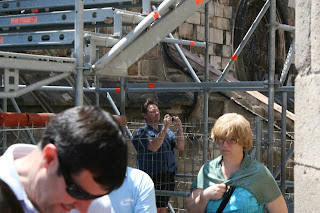
Yesterday I took my final walk down the rambles to check out the Mercat St. Josep (a.k.a. La Boqueria). This market was first opened in the early 13th century and primarily sold meat. Today, however, the market sells just about everything. Strolling through it I saw fish, fruits, vegetables, pastas, wine, cheese, eggs, and meat of all kinds.




 My Brazilian grandma would love this salted codfish
My Brazilian grandma would love this salted codfish
Here are some Croquetes which remind me of my grandma. She made the best ones.
On the way down to La Boqueria, I took a few pictures on Las Ramblas. I caught a photo of illegal street vendors selling bootleg items.
These guys open up their sheets and sell items for as long as they can before the police pass by. When the police come, they make a Santa Claus escape by grabbing the four corners of their sheets and running off with what looks like a large, white sack. It would be cool to get the police’s perspective on these characters.
Although too touristy for my tastes, the Ramblas has street performers which are entertaining to watch and imagine what they must be thinking day to day.
As one makes his way down the Ramblas, there are definitely genres of merchants clustered together. I am not sure the meaning of this - seems like it would promote unwanted competition. First there are clusters of pet stores then flower shops and then (expensive) tapas restaurants.
The Cathedral

The next stop was the city’s old Cathedral, which seems to be essentially dedicated to a young girl named Eulalia (Barcelona’s patron saint) who was tortured and crucified by the Romans at the age of 13 for her faith. Her body remains in an elaborately decorated sarcophagus below the high altar of the church shown below.

 I also got a chance to go up to the roof of the Cathedral and check out the views from above. There also seems to be a lot of construction and renovation going on.
I also got a chance to go up to the roof of the Cathedral and check out the views from above. There also seems to be a lot of construction and renovation going on.
The roof of the cathedral overlooking the mess of the old city
 Replacement of the old roof with newer material
Replacement of the old roof with newer material
 Celebrity shot: Rick Steves taking pictures for his new guide.
Celebrity shot: Rick Steves taking pictures for his new guide.
 Replacement of the old roof with newer material
Replacement of the old roof with newer material Celebrity shot: Rick Steves taking pictures for his new guide.
Celebrity shot: Rick Steves taking pictures for his new guide.Museu d’História de la Ciutat
 The final stop of the day was my favorite - the Museu d’História de la Ciutat (City History Museum). The tour started with an elevator, which descended to ruins discovered under the street level, some of which appear to be still in the process of excavation.
The final stop of the day was my favorite - the Museu d’História de la Ciutat (City History Museum). The tour started with an elevator, which descended to ruins discovered under the street level, some of which appear to be still in the process of excavation. outside of the city museum, which consists of multiple levels - the lowest ones dating back to 14 B.C.
outside of the city museum, which consists of multiple levels - the lowest ones dating back to 14 B.C.I wasn't allowed to bring my camera into the museum but I recorded some interesting facts:
Interesting fact 1: The Domus
The wealthiest homes in the city (those of nobles) were called “Domus(es)” – which is a closed, inward-facing home. These homes were built with an Atrium and the Peristylum (garden), both that were open to the sky and contained inward slanting roofs to collect rainwater.
Interesting fact 2: Urine, ash, and lime to wash clothes
Laundry facilities in ancient Barcelona were influenced by the Romans. Outside the clothes washing facility would be a place where locals were encouraged to urinate. Urine was combined with lime and allowed to decompose to form ammonia (bleach). This was used with ash to clean clothes.
Interesting fact 3: Fish cleaning and processing facilities
Similar to laundry facilities, fish would be processed (chopped and washed) in their own facility. Fish blood and intestines were placed into a vessels called maceration tanks and allowed to ferment for 2-3 months. The product was called garum, which was a tasty, very expensive sauce enjoyed by the wealthy. Sounds pretty gross to me.
Interesting fact 4: ½ to ¾ liters per day!
Wine making was a huge deal here in and adults and children consumed it in large quantities (½ to ¾ liter per person per day). It was thought to have medicinal properties so I guess that made it all the more acceptable to drink. Much of the ruins unearthed (600 sq. meters), which were included in the museum, were that of wine making and storing facility.







No comments:
Post a Comment